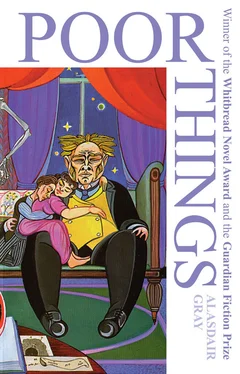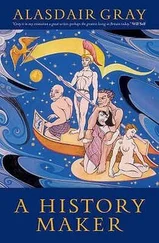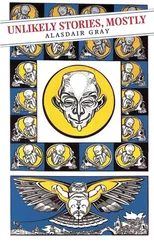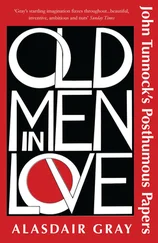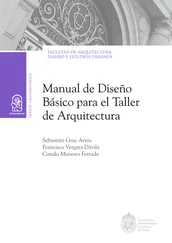9. The proper name is The Stewart Memorial Fountain, since it was erected to commemorate the work of Mr. Stewart of Murdostoun, Lord Provost of Glasgow in 1854. Against strong opposition from the private water companies he got an Act of Parliament passed which enabled Glasgow Corporation to turn Loch Katrine, thirty-three miles away in the depths of the Trossach mountains, into the city’s main public water supply.
However, Dr. McCandless’s mistake is understandable. Designed by James Sellars I.A. and erected by the Water Commissioners in 1872, the fountain is elaborately carved with creatures found on the Loch Katrine islands: heron, otter, weasel and owl. On the summit is set the graceful figure of Helen, the Lady of the Lake herself. Oar in hand she stands erect behind the prow of a delicately imagined bark, exactly as Fitz-James beheld her in the most famous poetical work of Sir Walter Scott.
Around 1970 the authorities turned the water off and made the stonework a children’s climbing frame. The sculptures got broken. In 1989, as Glasgow prepared to become the European Cultural Capital, it was fully repaired and set flowing again. In July 1992 it is waterless once more. A high timber wall surrounds it.
10. The steeply raked terraces of Glasgow’s West End Park were designed in the early 1850s by Joseph Paxton, who also designed Queen’s Park and the Botanic Gardens. The acute angle of the slope made it useful to Percy Pilcher when testing one of the gliders which eventually led to his death in 1899, but established the main structure of the aeroplane as it has developed to this day, and even gave the ‘aeroplane’ its name. The Pilcher connection may have led H. G. Wells to use the West End Park in his novel The War in the Air , published a month before the 1914–18 war. Wells describes Britain’s first successful airman flying from London to Glasgow and back without stopping. As he circles above the park on a level with the highest terrace he shouts to the astonished crowds there, “Me muver was Scotch!” and is wildly applauded.
11. Weather reports show that 29th June 1882 was abnormally hot and sultry. At sunset most Glaswegians were disturbed by a noise whose cause was discussed in the local press through the following fortnight. Most folk assumed it had an industrial origin and came from very far away. At Saracen Cross in the north-west folk thought something had exploded at Parkhead Forge; around Parkhead to the south-east it was thought a disaster in the Saracen Head Ornamental, Hygienic and Sanitary Iron Works. In Govan to the south-west folk thought a new kind of steam whistle was being tested in the north-east locomotive works; in the north-east it was assumed that a boiler had burst in a ship on Clydeside. A scientific correspondent in The Glasgow Herald said the phenomenon had been “more like an electrical shock than a noise”, and perhaps had “a meteorological source in an abnormal weather condition combining with fumes in the atmosphere”. A humorous periodical called The Bailie pointed out that the West End Park and University were at the centre of the area over which the noise was heard, and suggested that Professor Thomson was experimenting with a new kind of telegraph which went through air instead of through wires. A final facetious letter in The Scotsman (an Edinburgh journal) suggested that a Glasgow tinker had been playing a new kind of bagpipe.
12. Michael Donnelly has shown me the original plans of Park Circus, designed by Charles Wilson in the 1850s, plans which show a coach-house dividing the backyard of 18 Park Circus from the lane. But the fact that an architect designed such a feature would not prevent it being built till much later. The builders of the gothic cathedrals took centuries to complete their architects’ designs. The National Monument in Edinburgh, though designed to commemorate the Scots soldiers who died fighting Napoleon, is still little more than a façade.
13. Railway timetables from the 1880s show that it was possible to get off the first Midland Line night train from Glasgow to London at Kilmarnock and continue the journey on the second train which left an hour later.
14. It was improvident of Wedderburn to do so since this insurance company (now called Scottish Widows) is still a highly flourishing concern. In March 1992, as part of Conservative publicity preceding a General Election, the chairman of Scottish Widows announced that if Scotland achieved an independent parliament the company’s head office would move to England.
15. The Royal Exchange, in Queen Street, was erected and opened on 3rd September 1829. It was built by subscription at an expense of £60,000, and was not only a lasting monument of the wealth of the Glasgow merchants, but the noblest institution of the kind in Britain for many decades afterward. This splendid structure is built in the Grecian style of architecture from designs by David Hamilton. The building is entered by a majestic portico, surmounted by a beautiful lantern tower. The great roof is 130 feet in length and 60 in breadth; the roof, supported by Corinthian pillars, is 30 feet in height. The interior is now occupied by Stirling’s Public Lending Library, and as magnificent as ever.
16. Most visitors to Odessa know the great flight of stairs down the cliff to the harbour front. The granite stairway in Glasgow’s West End Park (erected in 1854 at a cost of £10,000) is equally substantial and handsome, but unfortunately in a corner where it is seldom seen and not much used by the public. Had it been erected nearer the central slope from Park Terrace it would have confronted Glasgow University across the narrow valley, and appeared to greater advantage.
17. The Russian gambler’s speech which starts: “Well,” he said with a rueful smile , and ends: “bed bugs too must have their unique visions of the world,” shows he was steeped in the novellas of Fyodor Dostoyevsky. Bella could not have known this, as the great novelist had died the year before (1881) and was not yet translated into English.
18. According to The Scots Kitchen (by Marian McNeill, Blackie and Son, Bishopbriggs, 1929) this recipe omits two vital ingredients: half a teaspoonful of baking powder and a moderate amount of heat.
19. A meticulous search through the public records and newspapers of the period has unearthed no evidence that “Harry” Astley ever existed. All Scottish and several English readers will have raised their eyebrows on reading that he claimed to be a cousin of “Lord Pibroch”. Pibroch is the Gaelic name for bagpipe , and the Scottish College of Arms, like the English, insists that all titles are taken from place names. To a foreign ear, however, all decidedly Scottish names sound equally plausible, which indicates Astley was an impostor. No firm of sugar refiners called Lovel and Co. is listed in the commercial registers of the period. Who could Astley have been? Our only clue is in his undoubted links with Russia and his history lectures to Bella. These prove that behind his English façade lay no love of the British Empire. He was probably a Tsarist agent, visiting London to spy on the emigré Russian revolutionaries who sheltered there. Herzen and (much later) Lenin were the most famous of these. It is a good thing Bella refused Astley’s offer of marriage.
20. A midinette is a French work girl, especially a young milliner or dressmaker. Their wages were low but they often knew how to dress well, so moneyed men regarded their class as a source of cheap mistresses.
21. Charcot, Jean Martin (1825–93), French physician, born in Paris. He graduated as M.D. of Paris University in 1853, and three years later he became physician of the Central Hospital Bureau. In 1860 he was appointed professor of pathological anatomy in the medical world of Paris, and in 1862 he began his connection with the Salpêtrière which lasted all his life. He was elected to the Academy of Medicine in 1873, and in 1883 was made a member of the Institute. He was a good linguist and had an excellent knowledge of the literature of other countries as well as his own. He was a great clinical observer and pathologist. He spent much of his time in studying obscure morbid conditions such as hysteria in relation to hypnotism. His work at the Salpêtrière was chiefly in the study of nervous diseases, but besides his labours in the field of nerves he also published many able works on the subjects of liver and kidney diseases, gout, et cetera. His complete works came out in nine volumes between 1886 and 1890. He was extraordinarily successful as a teacher, and his many followers were most enthusiastic in their work. Dr. S. Freud was among his pupils.
Читать дальше
